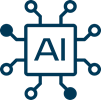The move happens as part of the bank’s Forward ’28 strategy on increased investments in digital platforms. Specifically, to determine how generative AI can help employees and customers.
The effort includes tools such as:
- DanskeGPT, which has been released for internal use among employees.
- Microsoft 365 Copilot, which is being explored as a proof of concept.
- GitHub Copilot, which is also running as a proof of concept.
- DanskeGPT as an internal smart assistant, which is planned to start testing in the near future.
The project is part of a broader strategic focus on the technological area, which includes repositioning to cloud, new technology, new applications, and artificial intelligence. It is expected that this development will aid in keeping up with new technology, increase productivity and give employees an opportunity to work with and experience the new tools.

One tool, DanskeGPT, has already been released, while others are currently being explored as possible investment opportunities. Some tools can aid employees in specific tasks such as writing or testing code, while others can help with time consuming duties such as writing summaries, meeting notes or creating presentations.
It is anticipated that the use of generative AI will enable employees to focus on core responsibilities and projects and hence create a more efficient and engaged working environment.
The introduction of new AI tools also means that Danske Bank is in the process of identifying several new competences that are needed in the work with generative AI. This implies, among other things, that the bank is looking for talents to fill in new jobs that that the bank did not even know existed a year ago.
"The potential is huge, and I am certain that as we embrace this new technology more widely, it will be a positive change to how we work and a great support in our efforts to provide great products and services to our customers,” says Frans Woelders.
AI tools we are testing or releasing
-
The bank’s new generative AI, called DanskeGPT, has been released to employees except for those based in the UK and US. DanskeGPT gives access to a version of Open AI’s ChatGPT 4.0, which is adapted to the bank's specific security requirements. Among other things, this means that no data flows back to OpenAI when employees use the tool.
DanskeGPT can help employees with a wide range of tasks such as writing emails, preparing reports, brainstorms, guide in various topics, translating, coding and much more.
The purpose is for DanskeGPT to contribute to an increase in productivity and give employees the opportunity to devote themselves to the more interesting and customer-oriented services and tasks, while the AI takes care of some of the underlying basic undertakings. -
Microsoft 365 Copilot is an AI-powered natural llanguage interface that enables users to interact with Microsoft 365 apps just like they would chat with a colleague. At the moment it is running as a proof of concept.
The tool is powered by large language models and can help improve productivity by providing relevant recommendations and assisting with tasks such as writing documents, summarising emails, and finding documents in applications like Word, Outlook, Teams and PowerPoint.
The bank expects that the implementation of Microsoft 365 Copilot will assist employees in dealing with tedious, time consuming or difficult tasks and thus free up time for more value-adding activities. -
GitHub Copilot is an advanced AI coding assistant. This Copilot helps software developers write code quicker and more efficiently. Working as a plugin it can generate code, write unit tests, refactor code and do much more to ease and speed up development work.
Currently, it is running as a proof of concept where a number of senior developers from the bank are participating.
This copilot is also expected to raise productivity and help create faster and better products and services to the benefit of the customers. -
The aim here is to train DanskeGPT to be an internal chatbot that can answer questions within the organisation on a range of topics that are currently handled manually by support teams or by employees having to navigate our support platform on their own.
This tool is expected to be made available to employees later this year.




